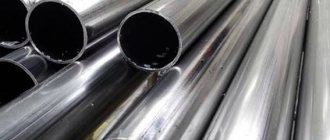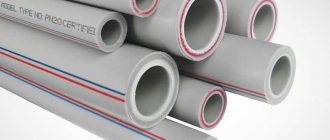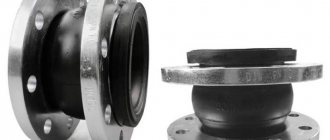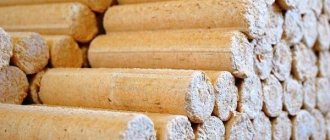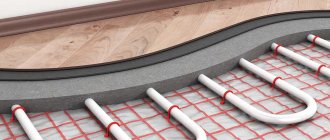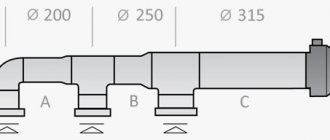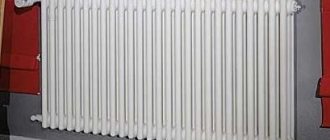Asbestos cement pipe: what is it?
Asbestos pipes are made from two main components, which are Portland cement and asbestos fiber. Water is used to obtain a uniform consistency. The use of these materials makes it possible to obtain a material that is light in weight and has a low thermal conductivity. Asbestos cement is a cement mortar that is reinforced with asbestos fiber. Asbestos undergoes a grinding process to a powdery consistency, after which it is separated into fibers. It is these fibers that are the connecting link in the concrete mixture.
Asbestos pipes gain strength by reinforcing concrete with asbestos fiber. This allows you to increase strength by 40% compared to conventional concrete devices.
A significant advantage of asbestos is its low thermal conductivity. It is due to their low thermal conductivity that asbestos pipes are used for the construction of sewer pipelines with high freezing rates. A significant advantage of asbestos pipes is the absence of electrocorrosion properties. If the service life of metal pipelines, in which the phenomenon of stray currents is observed, is reduced to 4-5 years, then asbestos pipes, with such a negative influence, can last tens of times longer.
When choosing asbestos pipes, it is important to take into account such parameters as the diameter and length of the products. The products under consideration are of two types: pressure or non-pressure. Below is a table with technical parameters for pressure and non-pressure asbestos pipes.
How to choose the diameter of an asbestos pipe
Asbestos cement pipes are made from a mixture of cement and asbestos (a natural mineral). This mixture allows you to achieve high pipe strength, namely fire resistance, resistance to mechanical damage and low temperatures, and so on. It is these qualities that determine the wide range of applications. The main thing for each system is to choose the right diameter of the asbestos pipe.
Asbestos cement pipes of different diameters
What are the products in question?
In the Russian Federation, asbestos-cement pipes with a length of 3.9 to 5 meters are manufactured. The dimensions of asbestos-cement products are as follows:
- 100 mm;
- 150 mm;
- 200 mm;
- 250-500 mm.
The diameter of the pipes is an important parameter, therefore, depending on its size, pipes are used for various purposes. The strength of the products under consideration is influenced by such an important parameter as the thickness of the pipe walls. To connect asbestos-cement materials into the main line, special connectors made of a similar material or PVC are used.
Asbestos is a non-toxic substance that does not emit toxins or radiation. The only major danger is asbestos dust, which is formed when sawing pipes.
To avoid dust entering the body, work must be performed exclusively in respirators or masks.
Types of pipelines
Asbestos-cement types of pipes are used where it is impossible to use metal. Metal is not used where there is high humidity, so non-pressure options are taken into account.
The considered version of the products has a bending strength of 30 MPa. The compressive strength is equal to 90 MPa. These are quite significant figures, especially considering that the material has a low density.
Asbestos pipes can withstand 60 defrost cycles, which allows us to judge a long service life.
The material in question comes in two types: non-pressure and pressure, as discussed above. Let's look at the difference between an asbestos-cement non-pressure pipe and a pressure pipe.
- Non-pressure types of asbestos-cement pipes are used exclusively where there is no pressure. These application systems include: chimney, ventilation, sewerage. Non-pressure or gravity-flow products are used in construction, from which foundations and fences are constructed. This type of pipeline is used to construct underground channels for laying communications.
- Asbestos-cement options for pressure pipes are used where materials under pressure are transported through products. The medium of these materials can be presented not only in the form of liquid, but also gas. Pressure versions of the product are used for installation of water supply systems, gas supply and irrigation systems.
The differences between pressure and non-pressure pipes lie in their sizes. These dimensions are: wall thickness and pipeline diameters. In a free-flow pipeline, the wall thickness ranges from 7 to 18 mm. In pressure products, the wall thickness ranges from 9 to 43.5 mm. The internal diameter of the first option reaches values from 50 to 500 mm, and of the second type of pipes up to 600 mm. Pressure products can withstand pressure from 3 to 12 atmospheres.
To combine asbestos-cement products of pressure and non-pressure types, various types of couplings are used. For non-pressure products, ordinary asbestos rings are used, and for pressure products, rings with rubber seals are used.
Characteristics of pressure pipes
The main feature of pressure asbestos-cement products is their ability to withstand high water pressure. They can be used in the construction of heating mains, sewers, and water supply systems. They are also used in the ventilation system and in the construction of collectors.
Characteristic requirements for pressure pipes:
- The quality of the product is determined by the conical ends of the pipes;
- Mandatory tests for resistance to high pressure, the product must not allow water to pass through;
- The kit must include mounting couplings.
Advantages
Compared to other pipeline options, the products in question have a number of different advantages. These products are easy to install, highly reliable and durable. They are highly resistant to both aggressive environments and moisture. If we compare products with metal counterparts, the latter option has a much shorter service life.
Metal products require replacement or repair after 5-10 years. Moreover, metal pipes are subject to negative influences not only from the outside, but also from the inside. Corrosion causes a narrowing of the internal diameter, which results in a decrease in pressure. Even when carrying out repairs, which involves blowing out metal devices, the problem cannot be solved. This is explained by the fact that rust does not disappear on the walls and continues to destroy the material.
If water is supplied through asbestos pipes, the material only gets stronger over time. This is explained by the compaction of the walls due to the hydration of the cement mixture.
Some of the main advantages of asbestos-cement products include the following factors:
- The material does not require waterproofing.
- Resistance to temperature fluctuations.
- There is no electrical conductivity.
- High resistance to aggressive environments and moisture.
- There is no condensation when cold water is supplied through pipes.
- Fire safety.
- Possibility of transporting liquid through pipes with a maximum pressure of up to 12 atmospheres.
- The average service life is 30-35 years.
Studies that were carried out in Germany, Switzerland and the USA confirmed the fact that asbestos is a safe substance among its analogues. Once it enters the body, rapid elimination occurs.
How and how to cut asbestos pipes
When assembling building structures made of asbestos, it is almost impossible to avoid cutting them. There are several ways to cut asbestos-cement pipes.
- Using an angle grinder (grinder).
This method is the most effective and provides high quality cuts. Cutting asbestos pipes is carried out with diamond saw blades or concrete saw blades. In order to minimize the amount of asbestos-cement dust generated during the cutting process, it is better to work together: the operator, using a grinder, cuts the pipe, and his assistant ensures a continuous supply of water to the cutting zone.
Important! Since fine asbestos-cement dust has carcinogenic properties, the use of protective respirators is mandatory when processing the pipeline!
- Using a hacksaw.
Considering the fact that wet asbestos cement can be cut much easier than dry, the pipe should be wetted before cutting. Cutting is carried out along a pre-designated line, avoiding strong pressure. Although cutting with a hacksaw will require more time and effort, the amount of dust generated when cutting pipes with a hacksaw is much less than when cutting with a grinder. - Using a cutter.
A line is drawn along the circumference of the pre-moistened pipe at the cut site. An incision 2-3 mm deep is made along the marked line, after which the pipe is carefully broken. The main advantage of this method is the absence of dust. - Using a slate nail.
If you don’t have the necessary tool at hand, and you need to cut the pipe immediately, an ordinary slate nail can help. The pipe is wetted and a cutting line is applied. The nail is sequentially hammered into the pipe along the marked line, and then broken off. The closer the nail holes are to each other, the more accurate the cut will be.
In addition, an asbestos-cement pipe can be quickly cut with a circular saw if you install a saw blade with carbide tips on it.
Flaws
Like any material, asbestos-cement pipes have some disadvantages. It is important to note them in order to determine the need to use them for certain purposes. The main disadvantage of the materials under consideration is fragility. During transportation or installation, any mechanical impact can lead to damage to the integrity of the product.
Asbestos-cement pipes cannot withstand heavy weight, which leads to damage to sewer lines and pipelines. When installing chimneys made of asbestos, there is a violation of the integrity of the products, and when exposed to high temperatures, such materials can explode. The products also do not have sufficient heat capacity, so they are not able to maintain the necessary traction. Soot settles on the inner walls of the pipes, which over time helps to reduce the diameter, and therefore the throughput and traction.
Is asbestos cement harmful?
Perhaps the biggest disadvantage of asbestos-cement pipes is medical contraindications. Thus, some experts argue that structures made of such material installed in a residential area can lead to cancer in the future. Although the danger has been confirmed only by the amphibole variety of asbestos. This variety cannot only be used in construction, but even mined.
Chrysolite asbestos is freely available, but it is only harmful when the dust of this material is inhaled. As a rule, only workers in workshops where such structures are produced are at risk, but when using personal protective equipment, such a risk is minimized. In addition, if such asbestos gets into the lungs within 10 days, half of it is completely eliminated, and the remaining part can cause cough, allergies and in some cases asthma, but not cancer.
The finished product is practically safe. Harmful substances that can be formed when the pipe is heated are easily removed along with smoke and combustion products, so proper installation of the chimney is important.
Production Features
The manufacturing process of the products in question involves performing the following manipulations in production:
- Initially, asbestos must be crushed.
- 85% cement and water are added to 15% asbestos.
- The prepared mixture is poured into a special drum in the form of a mesh, in which the solution takes the shape of a pipe.
- After squeezing, a film is formed, the thickness of which does not exceed 0.2 mm. The width of this film is equal to the future length of the product.
- The film is wound onto the drum, resulting in the formation of a product.
The result is a pipe of a certain size and appropriate diameter, which is ready for use.
Installation features
Pipe laying is carried out according to certain requirements. These requirements include the following factors:
- Pipes with an internal diameter exceeding 150 mm require additional processing. It is required in order to obtain the appropriate dimensions and roughness.
- The products are connected using special couplings. These couplings are equipped with grooves as well as corresponding rubber sealing rings. For a certain pipe size, appropriate couplings are used. This type of connection design allows for a high-quality fit of the pipe to the coupling, which is important in the presence of internal pressure in the pipeline.
- A radial gap is left at the junction of the products. Such a gap is required in order to ensure deflection of the pipeline when the seal fails.
- Installation of pipes with diameters of more than 150 mm is carried out directly with indentations. This is done for the purpose of eliminating the need to install additional linear compensators.
When asbestos pipes are heated to temperatures above 100 degrees, the walls increase (asbestos modification) by 0.4 mm. To avoid failure of the rubber seal, it is deformed by the end parts by 0.2 mm.
When installing asbestos-cement pipes, the need for welding work is eliminated. This makes the job easier and also speeds up the installation process.
Advantages and disadvantages
In addition to the fact that an asbestos pipe is quite durable, it also has additional positive aspects:
- can withstand a certain threshold of negative temperatures;
- lasts a long time;
- has low hydraulic resistance;
- not affected by chemicals;
- resistant to high temperatures not exceeding 300 degrees;
- can be installed in open ground;
- low prices;
- has resistance to corrosion processes;
- has low weight;
- characterized by ease of connection, which occurs with a special coupling;
- wide variety of sizes.
Despite the fact that there are quite a lot of advantages, including the fact that an asbestos pipe is much more profitable to purchase compared to a brick pipe, it has many disadvantages:
- there is not a sufficient level of heat capacity to provide powerful traction;
- strongly absorbs condensate and various heavy substances from exhaust gases;
- there is no possibility of use in places and installations where the temperature exceeds 300 degrees;
- cannot be cleaned due to the inability to provide any access to the pipe in the form of a hatch;
- Possibility of mounting only in a vertical position;
- if the temperature is exceeded, the asbestos pipe can not only crack, but also explode;
- affects the human body by releasing harmful substances.
Asbestos pipe material is good for use for those heating systems that are not characterized by a high level of power, and the gases that exit the chimney have already cooled or are not able to heat the pipe to 300 degrees.
Asbestos pipe after explosion
Requirements for the production of asbestos-cement pipes
There are some requirements for the production of asbestos-cement pipes. Manufactured products must meet the following state standards:
- The diameters of the pipelines must comply with the requirements in accordance with GOST 539-80.
- After manufacturing the materials in question, they must be tested in accordance with GOST 11310-90.
During the Soviet Union, the products in question were used for the construction of reclamation canals. In those days, the use of such products for the construction of civil and industrial construction projects was not envisaged. The reason for this was a worldwide ban due to the harmfulness of asbestos. They became popular after the collapse of the Soviet Union, as chrysotile asbestos, which is harmless, began to be used for the manufacture of products. It was after this that appropriate standards were developed for the production of asbestos pipes for any needs.
In Simferopol, during the Soviet Union, an asbestos-cement highway was built, the length of which is 20 km. To construct this structure, pipes with a diameter of 700 mm were used. Today, products of this diameter are not produced.
Features of cutting products yourself
During the installation of asbestos cement pipelines, the need arises not only for connecting products, but also for cutting them. To perform this procedure, you will need to use a grinder and a diamond-coated disk.
Initially, you need to mark the place where the cutting will be done. To do this, use a tape measure, as well as chalk or a pencil. After the product has been marked (preferably along the entire outer diameter), it should be securely fixed. It is impossible to use a vice or similar devices for such purposes, as the integrity of the product will be compromised. At home, you can fix the product using two bricks or bars of the appropriate size.
After this, be sure to wear a mask or respirator to prevent inhalation of asbestos dust. A tool with any disk is suitable for cutting products of various diameters. After all, cutting will be performed sequentially along the marking line. The video below shows the process of how to properly cut asbestos products at home.
Another important point is the possibility of connecting asbestos products using plastic couplings. Such couplings are used for products with a diameter of up to 150 mm. The connection using PVC couplings is made by heating the coupling with a hair dryer. Instead of a hairdryer, a tank of hot water is used, into which the muff is lowered for 10 minutes. After this, the coupling is put on one end of the pipe, and then on the other until it stops.
Asbestos-cement products are popular. With their help, the process of constructing sewer lines is simplified not only for drainage, but also for laying communications.
Scope of application of asbestos cement pipes
Asbestos cement pipes are considered one of the most popular products in many construction fields. Structures made from this universal material are used even under difficult operating conditions, in which the shelf life of a metal pipeline would be no more than 2-3 years. The most common areas of application are the following:
- sanitary or technical water supply systems;
- drainage systems, storm drainage systems, channelless installation of waterproofing systems;
- free-flow sewers;
- water wells - as casing pipes;
- columnar and bored foundations - as formwork;
- ventilation systems and chimneys;
- decorative structures.
To simplify the connection of asbestos-cement pipes, there are a fairly large number of installation devices. Among the positive characteristics that influenced the widespread use of a/c pipes, the following can be noted:
- non-susceptibility to rotting and corrosion from prolonged contact with water, no need to build waterproofing;
- no influence of biological factors: an asbestos pipe is not damaged by rodents, it is resistant to aggressive substances from the soil;
- the internal surface of the product is not overgrown with silt, and mineral deposits do not form on it;
- dielectric properties of the material, the ability to resist electrochemical corrosion resulting from the influence of stray currents;
- pipes have low thermal conductivity: heat loss is minimal even in the absence of thermal insulation;
- high mechanical impact strength, durability;
- relatively low cost of products, making their use economical even when laying large-scale pipelines.
Even unconventional uses can be found for asbestos-cement pipes
Also, asbestos cement pipe can be used in households . Sometimes these products are used as floors for garages or small hangars, and serve as simple feeders for livestock.
